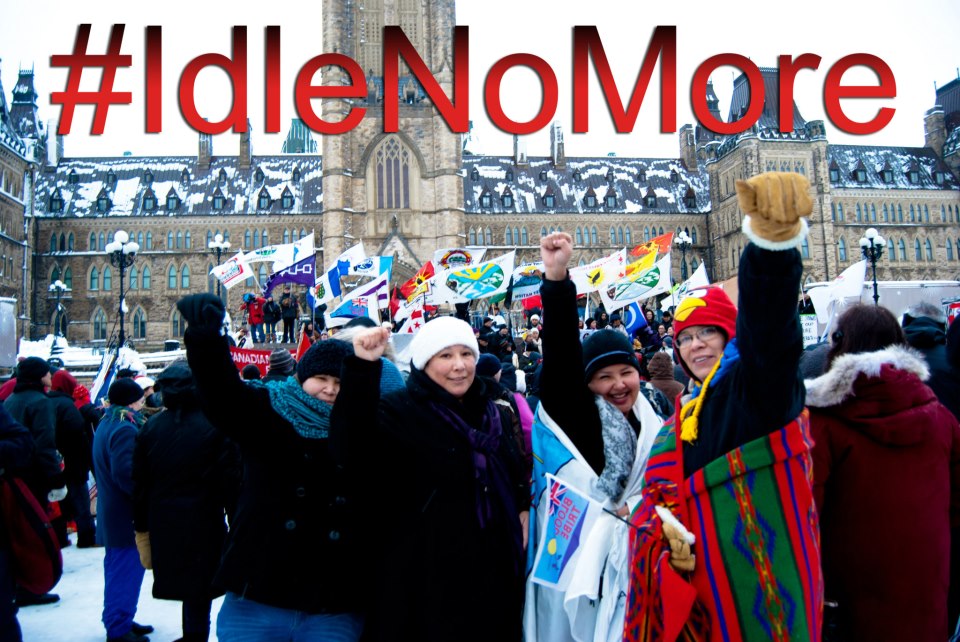Change the conversation, support rabble.ca today.
Those who want Indigenous people to lose this fight will tell you that we have to have only one leader for the others to talk with, one issue to talk about, and one solution. They are wrong.
What began as a teach-in morphed over just a few weeks into a movement, generating widespread protests across Canada and garnering increasing support from around the globe. INM is a great accomplishment and a source of hope born in the simple, peaceful demonstration of people power. All who fight for Indigenous rights know how dearly hope is needed and our thanks go to the leaders who are making this happen.
Then, on December 11th, Chief Theresa Spence led in a different way by starting her hunger strike on Victoria Island — unceded Algonquin territory a few hundred metres from Parliament Hill — and becoming a focal point for the protest and a catalyst for media coverage. We know how much we need media, here at home and around the world, to listen to Indigenous voices for a change. Her leadership is making that happen.
More recently, blockades of highways and railways have sprung up in a few spots around the country, flexing a little Indigenous muscle as a warning to an indifferent Prime Minister. And now Chiefs from communities across the country are setting a January 16th deadline before further action is taken. Because we know that the Harper government will not respond to the concerns of Indigenous people unless he sees the corporate interest in doing so, we also need this kind of leadership.
Given the breadth of the movement, it is hardly surprising that we have seen a diversity of interests and tactics emerging.
Given the complexity of the issues that gave rise to the movement, it is similarly unsurprising to see a diversity of solutions proposed.
And given the animosity of the federal government, most mainstream media, and much of the Canadian public to Indigenous rights, it is no more surprising that they portray any divergence within the movement as confusion and infighting among different leaders for “control”. We should all be able to recognize these divide and conquer tactics — they have been used many times before — and we know that they only can be defeated through unity.
INM believes in encouraging people to learn about Indigenous rights via teach-ins, rallies and social media; building relationships and creating understanding with allies across Canada; building relationships with international agencies such as the UN to raise and assert Indigenous sovereignty; and honouring the grassroots people who have worked, and continue to work towards these goals. These are the kind of constructive and non-threatening measures that get a positive reception from most Canadians. But, by themselves, they also tend to get ignored by the government, as they were when Bill C-45 was given Royal Assent on December 14th.
That is why the hunger strikes of Chief Spence, Elder Robinson and others are important. They get media, which makes people around the world notice. But this particular Prime Minister is willing to ignore even hunger strikers and consequent bad publicity.
And that is why road and rail blockades also serve a purpose. They get attention from the corporate entities that have the attention of the government, and that just might get a response. We’ll see soon.
INM was born in part because of the attack on our environment in Bill C-45. Environmentalists know a key value of bio-diversity is in creating resiliency. Monoculture farming is always in danger of losing entire crops to a single infestation or virus. Political action that limits itself to a single tactic runs a similar risk.
As Chief Spence said this week, “Let us come together in unity, because all of us, chiefs and grassroots, are one. If we are going to point fingers, let us point them squarely at this colonial government.”
Or as Grand Chief Derek Nepinak of the Assembly of Manitoba Chiefs said, “Some will express the energy through fasting, others will march, others will sing, others will fight, others will sit at tables and negotiate, and others will run from it because they are fearful of a future they cannot control.”
It may be that dancing and teach-ins have a longer-term effect through raising awareness in a respectful atmosphere that wins the understanding of other Canadians and leads to a true reconciliation at some point in the future. Personally, I would love to believe that is possible. That is part of the message of hope in INM. It is quite certain that such tactics have not moved and will not move Stephen Harper to act. To believe differently is to misunderstand that man.
It may be that hunger strikes also won’t be enough. They haven’t been so far and most of us would rather not see anyone die in order to test the full extent of the Prime Minister’s resolve (or obstinacy). Nor would we want to see what such an eventuality could catalyze across the country.
It also may be that blockades get no reaction, or people get arrested, or that attempted arrests lead to confrontation but no change in position by the government. None of those are desirable results either.
However, it may be that either singularly or in unison these efforts get results, that the federal government, provincial and territorial governments, and First Nation governments come together to sort out the mess that Canada has created, with mutual respect and an honest desire for a better future for all. If that happens, does it matter how we get there or which set of leaders get credit?
And if it doesn’t happen, I’d like to suggest a fourth direction, massive political mobilization in the next Canadian federal election. Because changing that leadership may be the most important step.




